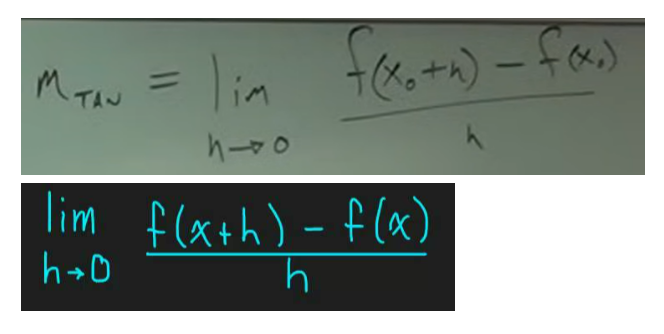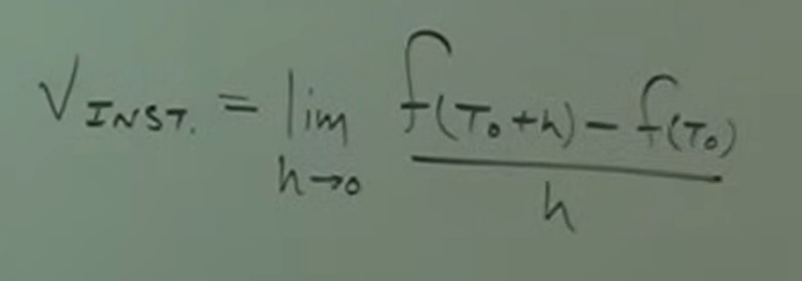10 Slope of a Curve, Velocity, and Rates of Change
1/14
There's no tags or description
Looks like no tags are added yet.
Name | Mastery | Learn | Test | Matching | Spaced |
|---|
No study sessions yet.
15 Terms
Main Objective for Solving for Rates of Change and Tangent Lines
(1) we are using limits to find the slope of the tangent line to a curve at a point
Slope of a Curve at a Point

Steps to Finding the Equation of A Tangent Line When Given: (1) Function, (2) Point, (3) Tangent Line Formula
Given: (1) Function, (2) Point
A. Slope — Limits
Step 1: Identify and write function in function notation — given function
Step 2: With the given point, identify X0
Step 3: With X0, identify f (X0 + h) and f (X0); leave the h alone, these are your inputs
Step 4: Use these inputs f (X0 + h) and f (X0) to plug into your given function to find the outputs of f (X0 + h) and f (X0)
Step 5: Use the outputs to plug into slope of a tangent formula
Step 6: Solve for the slope of a tangent but solving for the limit.
1) Plug and solve
2) Factor, simplify, plug and solve
3) Rationalize, simplify, plug and solve
Cross and simplify h in the denominator
B. Point-Slope Formula — Equation of a Line
Step 7: Solve for the equation of a line now with the slope of a tangent and the given point, by plugging in the point and the slope into the point-slope formula, and simplify
Point-Slope Formula

Does every single point of a curve have the same slope?
No. Every single point of that curve has a different tangent line, therefore a different slope every time.
Steps to Finding the General Slope of A Tangent Line (At Any Point) When Given: (1) Function, (2) Formula
Given: (1) Function, (2) Point
A. Slope — Limits
Step 1: Identify and write function in function notation — given function
Step 2: With the given point, identify X0
Step 3: With X0, identify f (X0 + h) and f (X0); leave the h alone, these are your inputs
Step 4: Use these inputs f (X0 + h) and f (X0) to plug into your given function to find the outputs of f (X0 + h) and f (X0)
Step 5: Use the outputs to plug into slope of a tangent formula
Step 6: Solve for the slope of a tangent but solving for the limit.
1) Plug and solve
2) Factor, simplify, plug and solve
3) Rationalize, simplify, plug and solve
Cross and simplify h in the denominator
Average Velocity Formula

Steps to Finding Average Velocity
Step 1: Identify and write function in function notation
Step 2: Find starting time or starting position, T0
Step 3: With T0, identify f (T0 + h) and f (T0), leave h alone, these are your inputs
Step 4: Plug inputs to get outputs
Step 5: Use outputs to plug into average velocity formula
Step 6: Solve for the slope, you will get a constant
Instantaneous Velocity Formula

Steps to Finding Instantaneous Velocity
Step 1: Identify the function, write in function notation
Step 2: Identify your time at that instant, T0
Step 3: With T0, identify f (T0 + h) and f (T0), leave h alone, these are your inputs
Step 4: Plug inputs to get outputs
Step 5: Use outputs to plug into instantaneous velocity formula
Step 6: Solve for the slope using limits
1) Plug and solve
2) Factor, simplify, plug and solve
3) Rationalize, simplify, plug and solve
Cross and simplify h in the denominator
Negatives are acceptable since they’re vector units
Steps to Finding Instantaneous Velocity at Any Time (General Slope of a Curve)
Step 1: Identify and write function in function notation — given function
Step 2: With the given point, identify T0
Step 3: With X0, identify f (T0 + h) and f (T0); leave the h alone, these are your inputs
Step 4: Use these inputs f (X0 + h) and f (X0) to plug into your given function to find the outputs of f (T0 + h) and f (T0)
Step 5: Use the outputs to plug into slope of a tangent formula
Step 6: Solve for the slope of a tangent but solving for the limit.
1) Plug and solve
2) Factor, simplify, plug and solve
3) Rationalize, simplify, plug and solve
Cross and simplify h in the denominator
Average Rate of Change Formula

Steps to Finding Average Rate of Change
Step 1: Identify and write function in function notation
Step 2: Find starting time or starting position, X0
Step 3: With X0, identify f (X0 + h) and f (X0), leave h alone, these are your inputs
Step 4: Plug inputs to get outputs
Step 5: Use outputs to plug into average rate of change formula
Step 6: Solve for the slope, you will get a constant
Instantaneous Rate of Change Formula

Steps to Finding Instantaneous Rate of Change
Step 1: Identify the function, write in function notation
Step 2: Identify your time at that instant, X0
Step 3: With X0, identify f (X0 + h) and f (X0), leave h alone, these are your inputs
Step 4: Plug inputs to get outputs
Step 5: Use outputs to plug into instantaneous velocity formula
Step 6: Solve for the slope using limits
1) Plug and solve
2) Factor, simplify, plug and solve
3) Rationalize, simplify, plug and solve
Cross and simplify h in the denominator